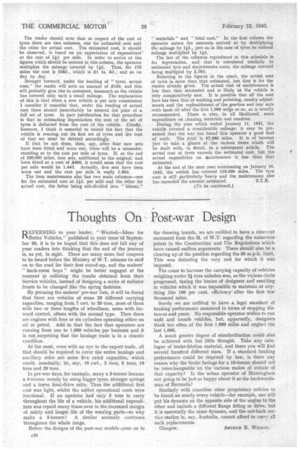Thoughts On Post-war Design
Page 28

If you've noticed an error in this article please click here to report it so we can fix it.
REFERRING to your leader, "Wanted—Ideas for 1•Better Vehicles," published in your issue 'of September 26, it is to be hoped that this does not lull any of your readers into thinking that the end of the journey is, as yet, in sight. There are many more fuel coupons to be issued before the Ministry of W.T. releases its staff on to the road for their first round-up, and the makers' "back-room boys" might be better engaged at the moment in collating the results obtained from their Service vehicles, instead of designing a series of radiator fronts to be changed like the spring fashions.
By perusing the makers' pre-war lists, it will be found that there are vehicles of some 20 different carrying capacities, ranging from 7 cwt. to 20 tons, most of them with two or three lengths of wheelbase, some with forward control, others with the normal type. Then there are engines with four or six cylinders operating either on oil or petrol. Add to that the fact that operators are running from one to 1,000 vehicles per business and it is not,surprising that the haulage trade is in a chaotic condition.
• At the most, even with an eye to the export trade, all that should be required to cover the entire haulage and ancillary sides are some five rated capacities, which could, nominallyi be, say, 10 cwt., 2 tons, 5 tons, 10 tons, and 20 tons.
In pre-war days, for example, many a 3-tormer became a 5-tonner merely by using bigger tyres, stronger springs and a lower final-drive ratio. Thus the additional first cost was light, whilst the added operational costs were tractional. If an opefathr had only 3 tons to carry throughout the life of a vehicle,'his additional expendi-, Imre was repaid many, times over in the increased margin of. safety and longer life of the wearing parts—so why make a 3-tonner? A similar anomaly continues throughout the whole range.
Before the designs of the post-war models come on to the drawing boards, we are entltled to have a clear-cnt statement from the M. of W.T. regarding the numerous points in the Construction and Use Regulations which have caused endless arguments. There should also be a clearing up of the position regarding the 30 m.p.h. limit. This was defeating the very end for which it was imposed.
The craze to increase the carrying capacity of vehicles weighing under 211 tons unladen was, as the vicious circle progressed, taxing the brains of designers and resulting in vehicles which it was impossible to maintain at anything like 100 per cent, efficiency' after the first few thousand miles.
Surely we are entitled to have a legal standard of braking performance measured in terms of stopping distances and years. No responsible operator wishes to run unfit and unsafe vehicles, but, apparently, designers think the often of the first 1,000 miles and neglect the last 1,000.
A much greater degree of standardization could also be achieved with but little thought. Take any catalogue of brake-friction material, and there you will find several hundred different sizes. If a standard braking perforinance could be required by law, is there any reason why the brake facings for a 10-tonner should nol be interchangeable 'on the various makes of vehicle of that capacity? Is the urban operator of Birmingham not going to be just as happy about it as the backwoodsman of Bermuda?
Similarly with countless other proprietary articles to be found on nearly every vehicle—for example, one will put his dynamo on the opposite side of the engine to the other and include a different flange fitting or drive, but it is essentially the same dynamo, and the out-back service station in, say, Australia, cannot afford to carry all such replacements.
Glasgow. ARTHUR R. WILsoN.




















































